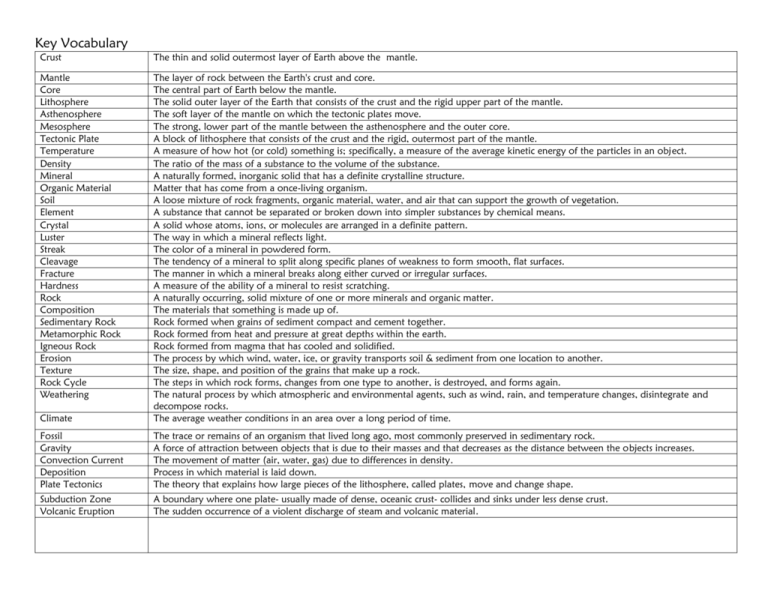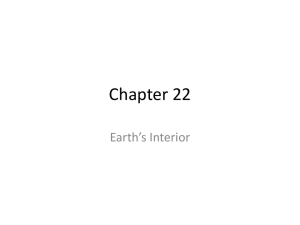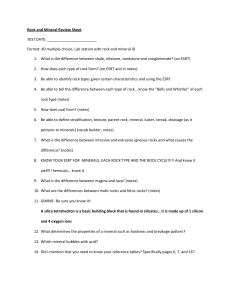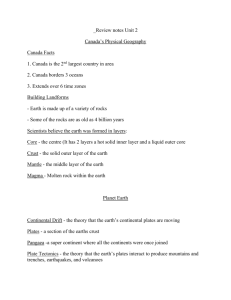File
advertisement

Key Vocabulary Crust The thin and solid outermost layer of Earth above the mantle. Mantle Core Lithosphere Asthenosphere Mesosphere Tectonic Plate Temperature Density Mineral Organic Material Soil Element Crystal Luster Streak Cleavage Fracture Hardness Rock Composition Sedimentary Rock Metamorphic Rock Igneous Rock Erosion Texture Rock Cycle Weathering Climate The layer of rock between the Earth's crust and core. The central part of Earth below the mantle. The solid outer layer of the Earth that consists of the crust and the rigid upper part of the mantle. The soft layer of the mantle on which the tectonic plates move. The strong, lower part of the mantle between the asthenosphere and the outer core. A block of lithosphere that consists of the crust and the rigid, outermost part of the mantle. A measure of how hot (or cold) something is; specifically, a measure of the average kinetic energy of the particles in an object. The ratio of the mass of a substance to the volume of the substance. A naturally formed, inorganic solid that has a definite crystalline structure. Matter that has come from a once-living organism. A loose mixture of rock fragments, organic material, water, and air that can support the growth of vegetation. A substance that cannot be separated or broken down into simpler substances by chemical means. A solid whose atoms, ions, or molecules are arranged in a definite pattern. The way in which a mineral reflects light. The color of a mineral in powdered form. The tendency of a mineral to split along specific planes of weakness to form smooth, flat surfaces. The manner in which a mineral breaks along either curved or irregular surfaces. A measure of the ability of a mineral to resist scratching. A naturally occurring, solid mixture of one or more minerals and organic matter. The materials that something is made up of. Rock formed when grains of sediment compact and cement together. Rock formed from heat and pressure at great depths within the earth. Rock formed from magma that has cooled and solidified. The process by which wind, water, ice, or gravity transports soil & sediment from one location to another. The size, shape, and position of the grains that make up a rock. The steps in which rock forms, changes from one type to another, is destroyed, and forms again. The natural process by which atmospheric and environmental agents, such as wind, rain, and temperature changes, disintegrate and decompose rocks. The average weather conditions in an area over a long period of time. Fossil Gravity Convection Current Deposition Plate Tectonics The trace or remains of an organism that lived long ago, most commonly preserved in sedimentary rock. A force of attraction between objects that is due to their masses and that decreases as the distance between the objects increases. The movement of matter (air, water, gas) due to differences in density. Process in which material is laid down. The theory that explains how large pieces of the lithosphere, called plates, move and change shape. Subduction Zone Volcanic Eruption A boundary where one plate- usually made of dense, oceanic crust- collides and sinks under less dense crust. The sudden occurrence of a violent discharge of steam and volcanic material. Standard: S6E5 S6E5. Investigate the scientific view of how the earth’s surface is formed. By the end of the unit, I will know how to: (S6E5a) ____ Compare and contrast the Earth’s crust mantle and core including temperature, density, and composition. (S6E5b) ____ Describe the structure of minerals. ____ Identify ways to determine the identity of minerals. ____ Investigate the contribution of minerals to rock composition. (S6E5c) ____ Identify the types of rocks and describe how they are formed. ____ Describe the rock cycle. ____ Describe how each type of rock changes into another type as it moves through the rock cycle. ____ Classify rocks by their process of formation. (S6E5d) ____ Describe processes that change rocks and the surface of the Earth. ____ Describe the differences between weathering and erosion. (S6E5e) ____ Recognize that lithospheric plates constantly move and cause geological events on the Earth’s surface. ____ Describe tectonic plates. ____ Describe Wegener’s hypothesis of continental drift. ____ Explain how sea floor spreading provides a way for the continents to move. (S6E5e) continued ____ Describe how new oceanic lithosphere forms at mid-ocean ridges. ____ Explain how magnetic reversals provide evidence for sea-floor spreading. ____ Describe the 3 types of tectonic plate boundaries and the 3 Forces thought to move tectonic plates. ____ Identify the common types of mountains. ____ Explain the difference between uplift and subsidence. (S6E5f) ____ Explain the effects of physical process (plate tectonics, erosion, deposition, volcanic eruptions and gravity) on geological features. ____ Landform development and ocean consistency are dependent upon the Earth’s physical processes which have been constant throughout time. ____ Constructive and destructive forces recycle crustal material. (S6E5g) ____ Describe how fossils show evidence of the changing surface and climate of the Earth. ____ Fossils are evidence of a region’s changing surface and climate. ____The layering of sedimentary rock provides evidence of time . periods in which they were formed. (S6E5h) ____ Describe soil as consisting of weathered rocks and decomposed organic material. (S6E5i) ____ Explain the effects of human activity on the erosion of the Earth’s surface. (S6E5j) ____ The student will describe methods to conserve natural resources such as water, soil and air.









